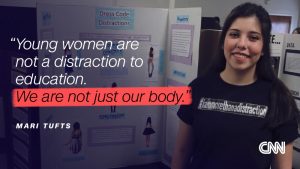This is Part 2 of a three-part series. Dress Code Season Part 1 introduced dress codes and explained why more schools are adopting them. Part 2 describes dress code discriminations, and Part 3 identifies action-oriented dress code solutions to those problems.
Dress code season is upon us, and what may have been considered normal school rules 10 years ago has become increasingly problematic as dress codes are interpreted and enforced by adults who have their own views of what is okay and what is not. Dress code discriminations result.
Dress codes that rely on subjective descriptors can be interpreted in as many ways as there are people, and result in misinterpretations and dress code discriminations. For example, these words are not enforceable in a consistent manner:
- Appropriate
- Modest
- Too tight
- Too short
- Suggestive
Dress codes are usually gender-based.
School dress codes for boys usually prohibit wearing items that could be gang-related or hold dangerous items. School dress codes for girls prescribe the width of their shirt straps, the tightness of their leggings, and the length of their shorts and skirts. Boys’ appearance is usually stigmatized for looking too thuggish or dangerous, while girls’ appearance is stigmatized for looking too sexual.
Family finances can play a part in a child’s appearance.
Buying clothes for growing children is very expensive, especially when so many students feel the pressure of fitting in by having the “right” look. A restricted budget may limit what clothing is available for students to wear, resulting in students wearing smaller sizes longer. Dress codes are especially hard on developing girls who may have limited resources to purchase clothing that is deemed “appropriate” for school. Parents tell me it is nearly impossible to find girls’ clothing that is age appropriate.
Culture plays a role as well.
Culture also plays a role in what students wear. Different cultures view skin in different ways. For example, in some cultures, it is fine to show a midriff, but not legs. When dress codes ignore culture, they discriminate against some students who don’t fit the predominant culture of the community.
Early developers bear the brunt of the violations.
Early developers are dress-coded more often than those who develop later. Girls who have not developed breasts may wear the same type of clothing as girls who have developed breasts, but only the girl who developed early gets called out for violating the dress code. This is a problem because it involves the sexualization of minor girls. It also calls negative attention to the normal and natural changes that occur during puberty; this body-shaming can cause lasting harm. Since most girls mature earlier than most boys, this is another reason they are more often singled out for dress code violations.Girls who get reprimanded for breaking the dress code are often told that they are a distraction to boys. Often, the punishment involves removing the dress-coded girl from her class(es) which disrupts her learning. In the worst cases, girls are publicly shamed as in the case where a student was forced to wear a pair of oversized red sweatpants and a bright yellow shirt with the slogan “Dress Code Violation” written on both. In response to being told that they were distractions to the boys, some students started a protest using the hashtags #IAmNotADistraction and #iammorethanadistraction.

One student, obviously a future scientist, did a survey to see if clothing that was not dress-code compliant was any more distracting to boys than clothing that was dress-code compliant. She found no difference. Let’s face it: Young people who are experiencing puberty, and the new hormone levels that accompany it, are prone to distraction no matter what people wear.
Here’s the heart of the problem.
When we penalize girls for the clothing they wear, holding girls instead of boys responsible for boys’ behavior, we are setting the stage for sexual harassment and assault. Blaming girls for boys’ bad behavior also perpetuates the rape culture that says, “If she hadn’t been wearing that ____, he wouldn’t have raped her.” Or “She was asking for it by wearing _____.” This is victim-blaming. The truth is, there is no dress code for avoiding rape.
There is nothing wrong with having a dress code, but…
If schools want to develop a dress code to ensure a safe and respectful learning environment, that’s fine. Schools prepare students for life, so teaching them how to dress for work versus play can be part of that task. The problems arise from developing a dress code that uses subjective language and targets certain groups of students over others. My next blog will discuss the ways schools can ensure that their dress code is fair, equitable, and enforceable.
Want to Learn More About Dress Code Discrimination?
- https://www.nytimes.com/2014/06/14/opinion/the-battle-over-dress-codes.html
- https://www.smithsonianmag.com/arts-culture/dress-codes-and-etiquette-part-1-what-not-to-wear-to-high-school-in-the-1960s-74464285/
- https://www.cnn.com/2017/05/30/health/school-dress-codes-body-shaming-girls-parenting/index.html
- https://news.wgbh.org/2017/05/22/local-news/school-dress-codes-are-tougher-girls-boys
- https://www.theguardian.com/education/2015/sep/07/restrictive-school-dress-codes-student-outrage
- Video: “Shame: A Documentary on Dress Codes” (student videographer)
Sign up to try a FREE sample lesson to see what Puberty: The Wonder Years is all about.
Updated 2022-7-24



